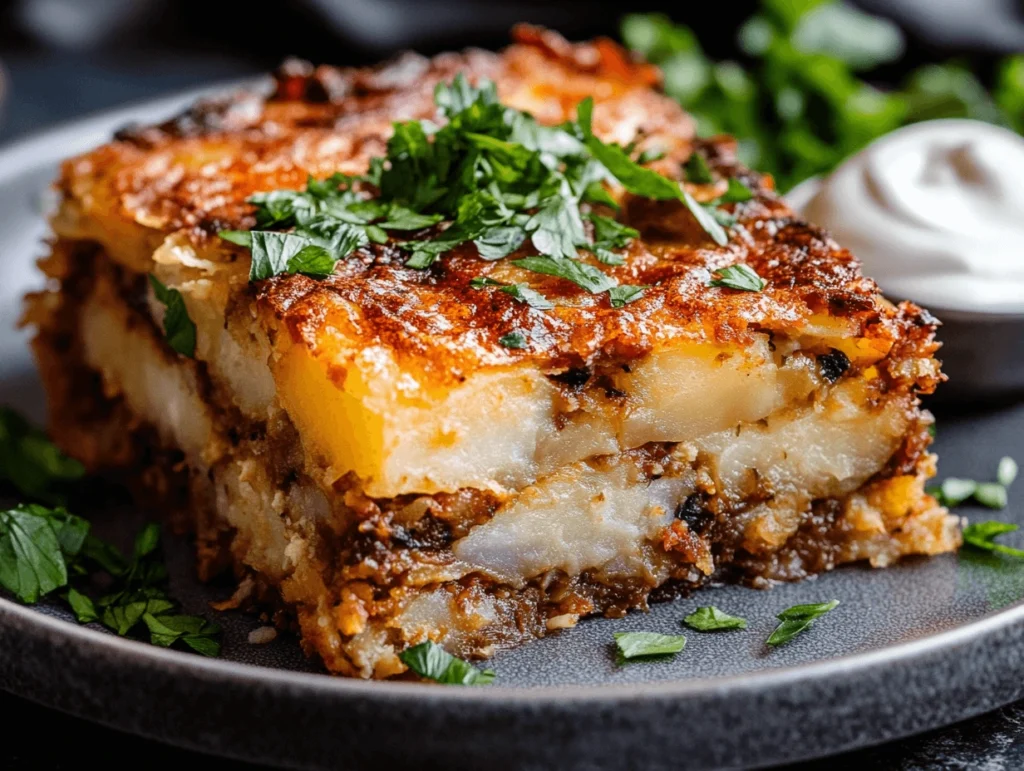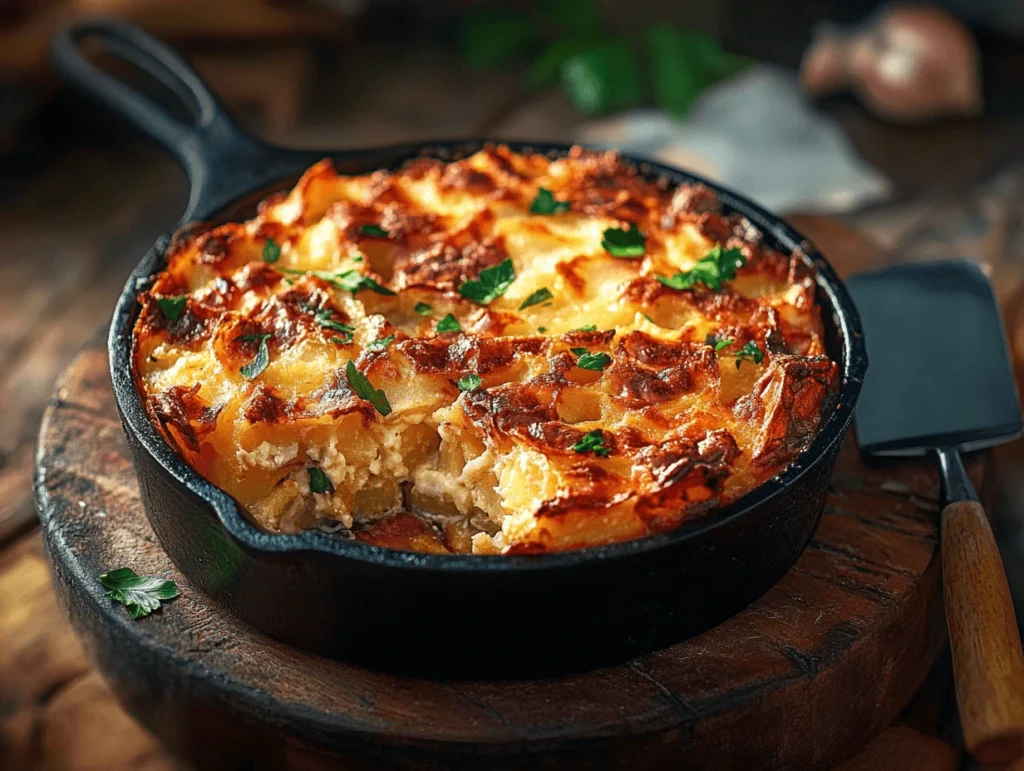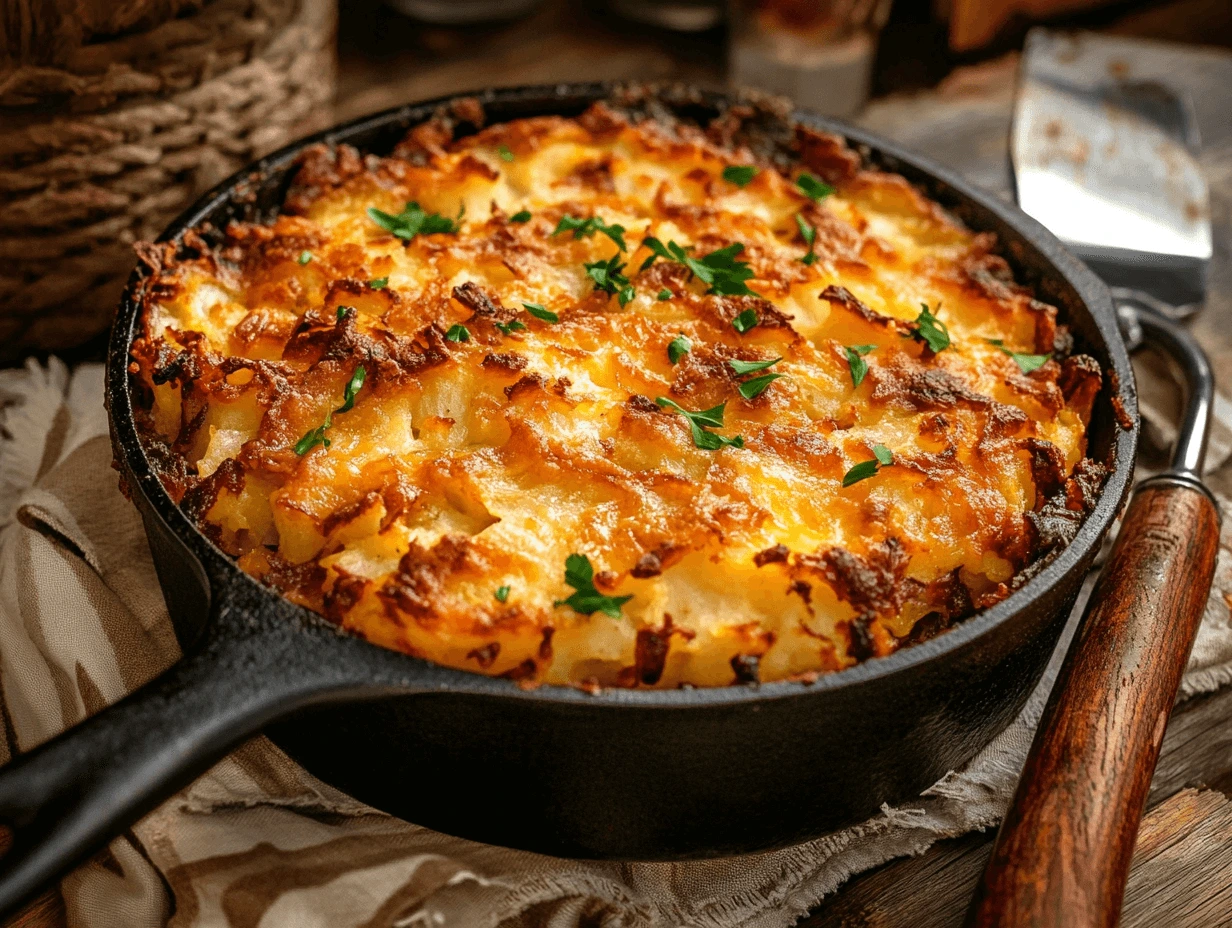Introduction
Potato kugel is a beloved dish that holds a special place in Jewish cuisine, especially during holidays like Passover and Shabbat. Known for its crispy top and soft, fluffy interior, this savory baked pudding has delighted generations with its comforting flavors. But what exactly goes into making this delicious dish? The question “What is potato kugel made of?” often sparks curiosity among both seasoned cooks and newcomers to Jewish culinary traditions.
In this article, we’ll explore the key ingredients that make up potato kugel, along with the techniques and variations that have made it a favorite across cultures. From the basics like potatoes, onions, and eggs to optional add-ins like schmaltz or herbs, we’ll uncover everything you need to know to create the perfect kugel. Let’s dive in!
Introduction to Potato Kugel
The History and Significance of Potato Kugel
Potato kugel traces its roots back to Germany over 800 years ago, where kugel first emerged as a baked pudding. Initially, kugels were sweet or made with noodles, but over time, Jewish communities in Eastern Europe adapted the dish to include potatoes. This change was largely driven by the availability and affordability of potatoes, making them a staple in many households.
Today, potato kugel has become a symbol of Jewish culinary ingenuity and tradition. Whether served during Passover, Shabbat, or other celebrations, it represents resourcefulness and a connection to cultural roots. Its simplicity and versatility make it a timeless favorite.
Why Potato Kugel Is a Holiday Favorite
What makes potato kugel so popular during holidays? First, it’s kosher for Passover when made without chametz, such as flour. Additionally, its rich, hearty texture pairs well with traditional holiday meals like brisket, matzo ball soup, or roast chicken. The dish’s ability to feed a crowd with minimal ingredients also makes it ideal for large family gatherings.
Potato kugel isn’t just food—it’s a nostalgic experience that brings families together. Its golden crust and savory flavors have become synonymous with comfort and celebration.
Core Ingredients of Potato Kugel
Essential Ingredients: Potatoes, Onions, and Eggs
When asking “What is potato kugel made of?” the answer always begins with its core ingredients: potatoes, onions, and eggs. Potatoes form the heart of the dish, providing the bulk and starch needed for its texture. Most recipes call for russet potatoes due to their high starch content, which helps create that golden, crispy crust.
Onions add depth and a subtle sweetness to balance the starchiness of the potatoes. Freshly grated onions work best, as their natural juices enhance the flavor and moisture of the kugel. Meanwhile, eggs act as the binding agent, holding everything together and giving the kugel its signature fluffy interior.
Together, these three ingredients create a base that is both simple and versatile, making potato kugel a timeless favorite.
Optional Additions: Schmaltz, Olive Oil, and Herbs
While the core ingredients are non-negotiable, optional additions can elevate a potato kugel from good to great. Schmaltz, or rendered chicken fat, adds a rich, savory flavor and is a traditional choice in many Jewish households. For those seeking a vegetarian option, olive oil works just as well, providing a lighter, yet still flavorful alternative.
Herbs like parsley, dill, or chives are popular add-ins, bringing freshness and a hint of color to the dish. Some recipes even include garlic or paprika for an extra kick of flavor. These variations allow cooks to put their own spin on the classic recipe while still honoring its roots.
Techniques for the Perfect Potato Kugel

Grating and Preparing the Potatoes
The texture of potato kugel largely depends on how you prepare the potatoes. Most recipes recommend grating them by hand or using a food processor with a shredding attachment. This creates fine shreds that bake evenly and contribute to the dish’s fluffy interior.
After grating, it’s crucial to drain the excess liquid from the potatoes. Some recipes suggest squeezing the shreds in a clean kitchen towel, while others recommend letting them sit in a colander. Removing the liquid ensures a crispier kugel and prevents it from becoming soggy.
Tips for Achieving a Crispy Crust
A crispy crust is what sets a great kugel apart, and achieving it requires a few key techniques. Preheating the baking dish before adding the potato mixture is a must. The hot dish helps the kugel develop its golden, crunchy edges right from the start.
Additionally, spreading a thin layer of oil or schmaltz on the dish before pouring in the mixture ensures even browning. To enhance the crust further, drizzle a small amount of oil over the top of the kugel before placing it in the oven.
Lastly, baking at a high temperature, typically around 400°F, allows the crust to form while keeping the interior moist and tender. Following these tips guarantees a kugel that’s as visually appealing as it is delicious.
Variations of Potato Kugel Recipes
Traditional vs. Modern Takes on Potato Kugel
Traditional potato kugel recipes rely on simple, time-honored ingredients: potatoes, onions, eggs, and fat, like schmaltz or oil. These classic versions focus on achieving a balance of crispy crust and fluffy interior, often baked in cast iron or metal dishes for optimal texture.
Modern variations, however, bring creativity to the table. Cooks experiment with additions like garlic, fresh herbs, or even caramelized onions to enhance flavor. Some also incorporate alternative oils, such as avocado oil, for a healthier twist. These innovations allow potato kugel to appeal to a broader audience while maintaining its cultural significance.
For more creative takes on classic recipes, explore Passover Potato Pie, which adds a unique spin to the traditional kugel concept.
Exploring Vegan and Gluten-Free Options
For those with dietary restrictions, potato kugel can easily be adapted to suit vegan or gluten-free preferences. To replace eggs, options like flaxseed eggs or aquafaba (chickpea water) work well as binding agents. Additionally, gluten-free potato kugel often substitutes traditional binding ingredients, like matzo meal, with potato starch or tapioca flour.
These adaptations make potato kugel accessible to a wider audience, ensuring that everyone at the table can enjoy its rich flavors and comforting texture.
Serving and Pairing Potato Kugel

Best Ways to Serve Potato Kugel
Potato kugel is incredibly versatile and can be served as a main dish or side. For Passover, it often accompanies dishes like brisket, roasted chicken, or matzo ball soup, balancing out the meal with its hearty texture. During Shabbat, potato kugel is a centerpiece that complements other traditional Jewish foods.
To enhance its presentation, consider serving kugel in slices garnished with fresh parsley or dill. This simple addition elevates the dish while adding a pop of color.
Perfect Pairings for Potato Kugel at Your Table
The mild, savory flavors of potato kugel pair beautifully with a variety of dishes. For a classic combination, serve it alongside roasted vegetables or a green salad dressed with lemon vinaigrette. If you’re feeling adventurous, pair it with smoked salmon or a dollop of sour cream for a unique flavor twist.
For more inspiration, visit Timeless Recipes for additional ideas on pairing and serving kugel at your next gathering.
FAQs About Potato Kugel
Can You Make Potato Kugel in Advance?
Absolutely! Many people prepare potato kugel a day before their event to save time. Once baked, allow it to cool completely before storing it in an airtight container in the fridge. Reheating is simple: place the kugel in the oven at 350°F for 20–30 minutes until it’s warmed through and the crust regains its crispness.
However, while making kugel in advance is convenient, it’s at its absolute best when served fresh. The crispy top and fluffy interior are most delightful straight out of the oven.
How Do You Store and Reheat Potato Kugel?
If you’re storing leftovers, refrigerate them in a covered dish or airtight container. Potato kugel can last up to three days in the fridge. When reheating, cover it with foil to retain moisture, then uncover during the last 10 minutes to restore its crispy crust.
For longer storage, freezing is an option. Slice the kugel into portions, wrap them in plastic wrap, and store in a freezer bag. To reheat, thaw the slices overnight in the fridge and warm them in the oven for 20–30 minutes.
for more FAQ read this Can Jews eat potatoes during Passover?
Conclusion
What Is Potato Kugel Made Of? Tradition and Versatility
So, what is potato kugel made of? At its core, it’s a simple blend of potatoes, onions, eggs, and fat. But beyond these ingredients, potato kugel represents so much more—it’s a dish rich in history, beloved in Jewish traditions, and adaptable to modern tastes and dietary needs.
Whether you stick to the traditional recipe or add your creative twist, potato kugel remains a celebration of comfort, flavor, and ingenuity. Its crispy crust and soft interior are sure to bring joy to your table, whether it’s for Passover, Shabbat, or any special occasion.


1 thought on “What is potato kugel made of?”